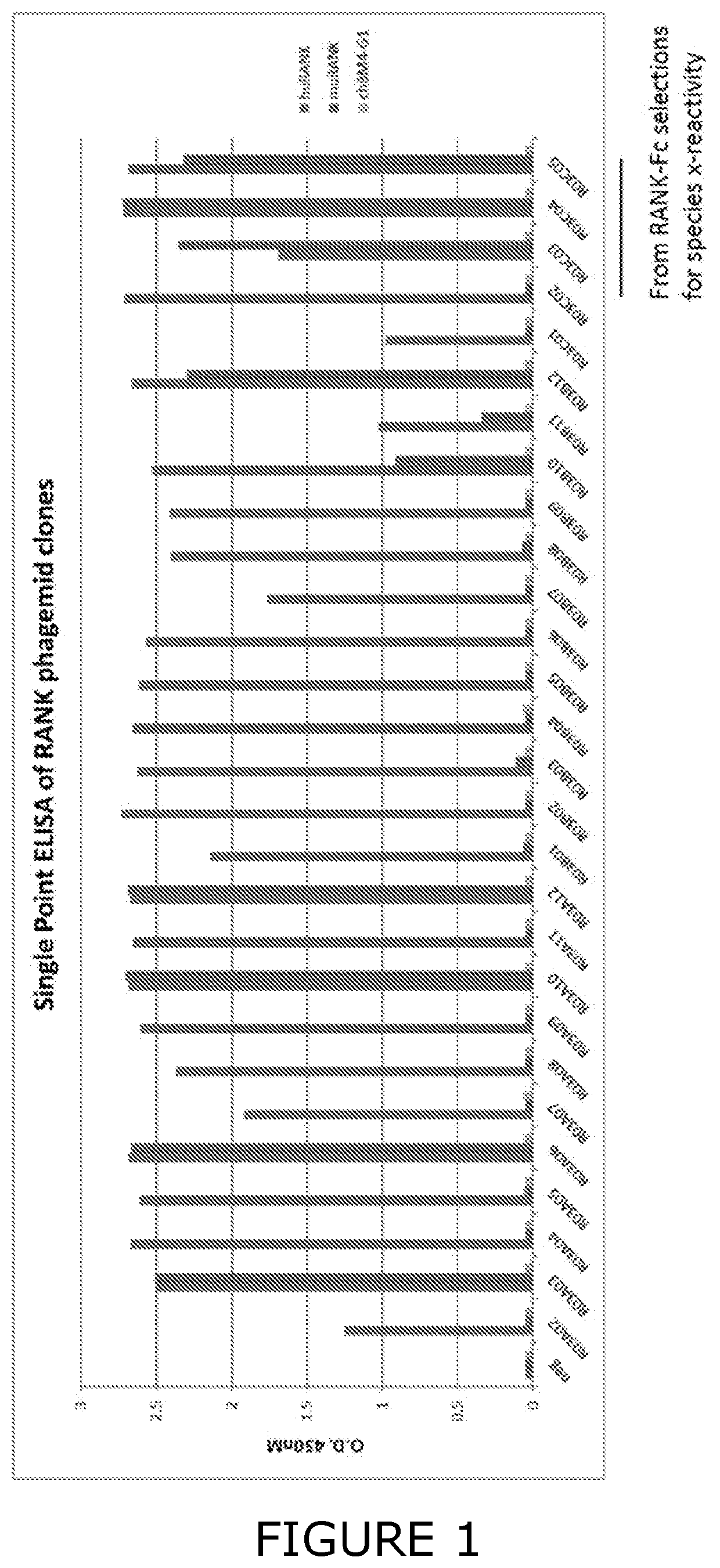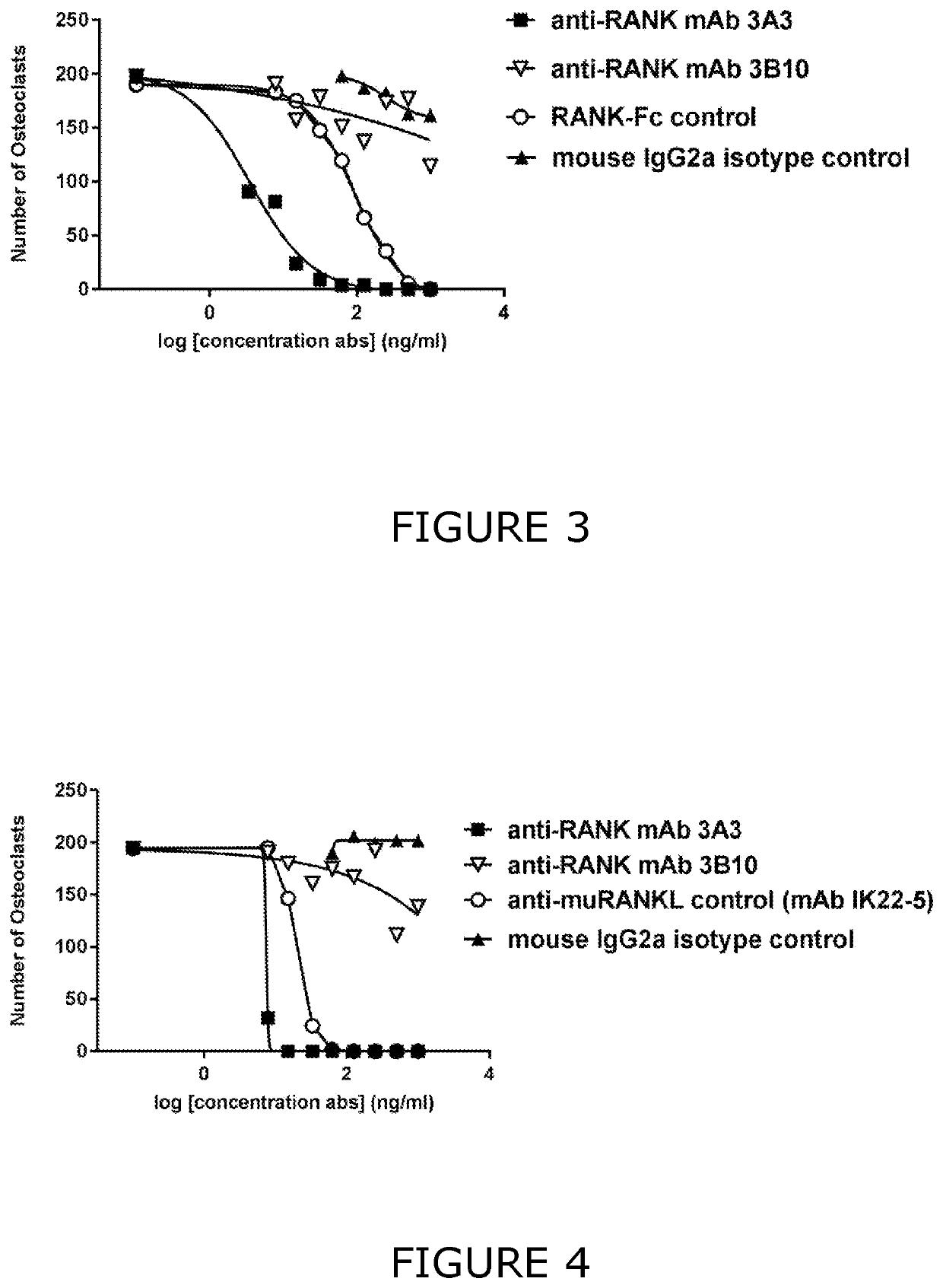Rank antagonists and uses thereof
a technology of antigen binding molecules and antagonists, applied in the field ofrank, can solve the problems of affecting the effect of denosumab, affecting the safety of denosumab, and affecting the safety of denosumab, and unable to meet the needs of patients,
- Summary
- Abstract
- Description
- Claims
- Application Information
AI Technical Summary
Benefits of technology
Problems solved by technology
Method used
Image
Examples
example 1
Isolation of Antagonist Anti-Rank Antigen-Binding Molecule
[0514]A fully human Fab-based antibody phage display library was obtained from CSL (Parkville, Melbourne, Victoria, AUS). General procedures for construction and screening human Fab libraries were described in de Haard et al. (1998, Advanced Drug Delivery Reviews 31, 5-31; 1999, J. Biol. Chem. 274:18218-18230).
[0515]The library was screened for Fab fragments which bind to the entire recombinant extracellular region of the RANK protein, to facilitate the identification of Fabs targeting an epitope within the CDR2 and CDR3 regions, thus enabling the antagonism of RANKL and cross-reactive binding with mouse RANK.
[0516]The phagemid library was screened for binders to RANK using RANK-Fc protein immobilized on Dynabeads® M-280 Streptavidin (Invitrogen™, Thermo Fisher Scientific 11205D) by biotin-anti-human Fc antibody capture (Jackson ImmunoResearch Laboratories 109-065-098). The selections were carried out following methods descri...
example 2
Antagonistic Activity of Anti-Rank Antibody in Cell-Based Functional Assay
[0523]To evaluate the functional inhibitory effect of the 3A3 antibody in a cell-based functional assay, the effect of this anti-RANK antibody on in vitro osteoclastogenesis was tested. The methods for the in vitro TRAP+ osteoclast assays were essentially as described (Simonet et al., 1997. Cell 89(2): 309-319). Bone marrow (BM) cells from normal BL / 6 mice were seeded in a 96-well flat bottom plate at a density of 25000 cells / well in a total volume of 200 μL / well of complete DMEM (10% FCS+PS+Glu) supplemented with 50 ng / mL of human recombinant CSF-1 (Preprotech). After culture for 48 hr, media was replaced with complete DMEM supplemented with 50 ng / mL of human recombinant CSF-1 and 200 ng / mL of soluble muRANKL or soluble huRANKL (Miltenyi). Cells were cultured with CSF-1 and either human or mouse RANKL for 4 days (with and without antibody inhibitors) and then TRAP+ multinucleated (more than three nuclei) oste...
example 3
Dual Blockade of Rank and PD-L1 Significantly Enhances Fibrosarcoma Tumor Immunity
[0528]Given the results presented in Example 2, which demonstrate that the anti-RANK 3A3 antibody has at least equivalent activity compared with the positive control RANK-Fc in a cell based RANKL / RANK antagonistic assay (in vitro osteoclast formation), the efficacy of dual blockade of RANK and PD-L1 in mice bearing subcutaneous tumors was assessed using antagonistic anti-RANK and anti-PD-L1 antibodies. In the anti-PD-L1-sensitive MCA1956 fibrosarcoma model, the addition of antagonistic anti-RANK mAb showed a significantly enhanced anti-PD-L1 efficacy (FIG. 5, P<0.0001). This observation supports that the antagonistic anti-RANK 3A3 antibody may improve anti-tumor immunity.
PUM
| Property | Measurement | Unit |
|---|---|---|
| Fraction | aaaaa | aaaaa |
| Fraction | aaaaa | aaaaa |
Abstract
Description
Claims
Application Information
 Login to View More
Login to View More - R&D
- Intellectual Property
- Life Sciences
- Materials
- Tech Scout
- Unparalleled Data Quality
- Higher Quality Content
- 60% Fewer Hallucinations
Browse by: Latest US Patents, China's latest patents, Technical Efficacy Thesaurus, Application Domain, Technology Topic, Popular Technical Reports.
© 2025 PatSnap. All rights reserved.Legal|Privacy policy|Modern Slavery Act Transparency Statement|Sitemap|About US| Contact US: help@patsnap.com



